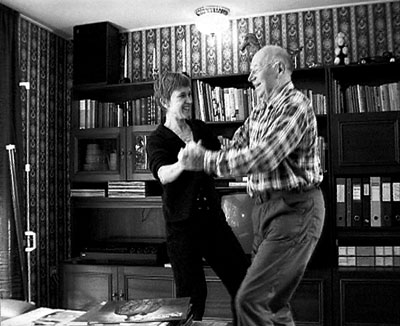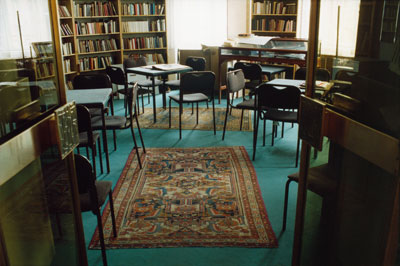Lives on Film
In her videos and installations, Gitte Villesen uses simple methods to create compelling biographical portraits
In her videos and installations, Gitte Villesen uses simple methods to create compelling biographical portraits

In A Silent Movie (2007), Gitte Villesen explores the history of the Fészek Artists’ Club, which has existed in Budapest since 1901. In the video, Villesen is given a tour of the club‘s premises by Eva Molnar, an elderly woman who has worked there since 1953. They walk through the building, which still testifies to its former grandeur. We hear about the end of state subsidies and about the club’s long-gone days as a centre of the city’s cultural life.
This work occupies a special position within Villesen’s oeuvre. Here, the interview – a format at the core of almost all of her videos – is seen taking place but is not heard. Instead, A Silent Movie has a soundtrack composed specifically for the piece in the style of bygone silent films. Molnar’s attachment to this place is expressed in her body language. The way she touches objects and fittings tells us more than her words, which appear as subtitles. In a way, Molnar ‘performs’ the Artists’ Club, establishing a special link between herself and the eventful history of the place.

Villesen captures her protagonists embedded in their lives, surrounded by the vital things that they deal with every day. The resulting videos are not so much rigorous documentaries as unobtrusive dialogues which take shape gradually, developing over the course of many encounters. Villesen is often heard as an off-camera voice, before the focus returns to the individuals in front of the camera speaking about themselves and their lives.
Rather than a systematic, sociological method, Villesen’s approach involves empathy and observation; the artist takes her lead from what her subjects are willing to set in motion and moves her camera accordingly. In this way, she finds the appropriate form and pace for each specific portrait, highlighting unusual trajectories.
Many of Villesen’s subjects are people whose lives are shaped by collecting, like the pensioner Willy Bøtker who stars in three of her early videos: Who Gets the Food?, Willy Goes For a Drive and Willy as DJ (all 1995). These four-to-nine minute portraits show Bøtker presenting some of his passions. In Willy Goes For a Drive, he shows off his unspectacular small car. Although he has owned 500 different models, he has never had more than one car at a time. In Willy as DJ, he plays his favourite records from his collection and even starts dancing with Villesen. His living room becomes the stage for an improvised performance celebrating an individual through the artefacts he has accumulated over a lifetime.

Although Villesen usually stands behind the camera – switching between static and handheld shots – she reveals her role as the filmmaker, mostly through her comments. In contrast to conventional documentary forms, this method tries to create a sense of equality between the interviewer and the interviewee. Moreover, many of her videos have an almost stubbornly casual quality, as if they were home movies to be projected for close friends instead of art works. Villesen’s work raises questions about the ethical and political dimensions of the documentary format. But in a certain way, with her individual approach to both her subjects and her camera, the artist seems to have anticipated the DIY production values of YouTube long before it existed. Nevetheless, her videos and the stories they tell have the staying power and the appeal of traditional film.
Her most recent series documents the four years she spent studying juju. This West African religion is based on the use of magic objects, the so-called ‘jujus’, which are made under specific conditions for a particular individual. Jujus tend to be small things – musical instruments, homemade hats, amulets – which are believed to offer healing and protection to their owners. The project developed out of the artist’s acquaintance with Amadou Sarr, a musician from Gambia who plays the molo and the m’bilipp. She met Sarr’s family during work on the video Juju (White Magic) (2008), a study of how the objects are made and used.

Villesen’s exhibition last summer at the Graz Kunstverein included I Will Arrange Everything. It Will Be the Best Film Ever (2009–10). This three-part video installation consists of three portraits: Sarr’s third wife Mariama Senghor (He Has to Have Knowledge), her mother Mariama Corr (Since You Ask, I Will Give It to You) and her grandmother Yenden Joff (An Important Story). The projection space was enclosed by long curtains made by Mariama Corr from brightly coloured fabrics. As three generations of juju culture unfold before the viewer, it becomes clear how much everyday life and social structures are permeated by this religion and its manifestation in objects.
During the interview sessions, Sarr is always on hand to interpret between Wolof and English. The English subtitles not only repeat his direct renderings but also show a ‘correct’ translation, which suggests occasional inaccuracies in his interpretations. The viewer can read between the lines of the story to gain a more complex portrayal of not only the individuals and their dealings with one another but also of the documentary process itself.

In I had no other choice than to jump from one pile to the other, as there was nothing in between (2012) – the most recent video in the series – Sarr plays the molo, on his own. In one song, he recounts a version of the story of creation in which two rival animals claim to be the oldest creature on Earth. Although their respective tales turn out to be nothing more than different versions of the same theme, the victor is the animal who recites the tale in the cleverest, most winning manner. This victory, in its way, may be a comment on the documentary endeavour itself.
Translated by Nicholas Grindell
















